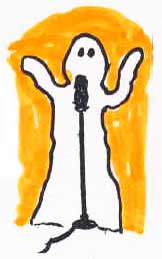|

This story was published in Radio Recall, the journal of the Metropolitan Washington Old-Time Radio Club, published six times per year.
Click here to return to the index of selected articles.
|
|
 THE HALLOWEEN BROADCAST THAT SPOOKED AMERICA THE HALLOWEEN BROADCAST THAT SPOOKED AMERICA
by Jack French © 2007
(From Radio Recall, October 2007)
The most significant, and compelling, radio drama in American broadcasting almost never aired. But because it did, the production of “The War of the Worlds” by The Mercury Theater on the Air mesmerized a nation, as no single radio drama had ever done....before or since.
A chance meeting in 1934 of a Bucharest-born grain dealer, John Houseman, and a kid from Kenosha, WI who had become Broadway’s “wonder boy,” Orson Welles, resulted in the formation of a famed, but short-lived, theater. This unlikely odd couple together produced a number of innovative plays independently in New York City in 1935-37, most under sponsorship of the WPA. This led them to their banned staging of The Cradle Will Rock, a powerful, anti-capitalist drama by Marc Blitzstein, in which the actors, prohibited from taking the stage, acted their roles from the aisles. The next day, Welles and Houseman were praised by most, jeered by some, and the WPA terminated their funding.
The energetic duo then founded their own company, the Mercury Theater, with a company of 34 actors and a capital of $ 10,500. They soon launched three Broadway hits in succession: Shoemaker’s Holiday, Heartbreak House, and a modern-dress Julius Caesar. Their success and laudatory reviews prompted CBS radio executives in June 1938 to offer Houseman and Welles a one-hour time slot. Welles had some radio experience; he was regularly on The March of Time and was the lead in The Shadow.
With Houseman producing and writing and Welles directing and acting, The Mercury Theater on the Air debuted on July 11, 1938 with an adaptation of Dracula. They had planned to do Treasure Island as their initial offering, but Welles pushed it to the second week to do more script revision. Throughout the summer, they aired nine more dramatizations. Off-mike there was frantic effort weekly with the attention of the principles divided between the stage productions and radio shows of the theater company. The daunting task of converting large novels within 2-3 days to a one-hour radio show was borne by Houseman until October 1938 when he hired Howard Koch at $75 a week to do the writing.
In the next three weeks, Koch transformed three novels into radio scripts: Hell on Ice, Seventeen, and Around the World in 80 Days. Welles wanted a spooky show for their October 30th broadcast so he handed Koch a copy of H.G. Wells’ 40 year old science fiction novel, The War of the Worlds. Orson thought the volume was too dated and too dull and instructed Koch to change the Martian invasion from England to the U.S. and write it as a news bulletin program. To do so, Koch would have to jettison most of the novel and write an almost-original play for a live broadcast less than six days away. Koch picked Grover’s Mill as the invasion landing by throwing a dart at a map of New Jersey.
After two days struggling, Koch told Houseman it couldn’t be done in time. They considered switching to Lorna Doone but couldn’t reach Welles for permission so Houseman joined Koch for two more days of writing, producing a script for Thursday’s rehearsal which showed it to be dull. The two worked through the night, gave a new script to the CBS censor, who demanded major changes. They worked on it until Sunday afternoon when Welles first saw it at rehearsal. He then rewrote most of the scenes.
At 8 PM Welles, actor and director, mounted his studio podium, the ON THE AIR sign flashed, and he began the total destruction of the Northeast region by Martian invaders. Thousands of duped listeners began to panic, first in NJ and then in Manhattan, running screaming into the streets. In Boston, terrified citizens climbed rooftops to see the red glow from the burning of New York City. Official denials from the network and the police did not convince those who telephoned authorities. But ultimately the chaos resulting from the broadcast did not result in any deaths, although there were some injuries within the panicked crowds.
Two years later, Princeton University commissioned a scholarly study of the incident and concluded that of the estimated six million people who heard the broadcast, nearly two million believed it was an authentic news program and had not realized it was a radio dramatization.
(Read more about this topic in our December issue.)
|